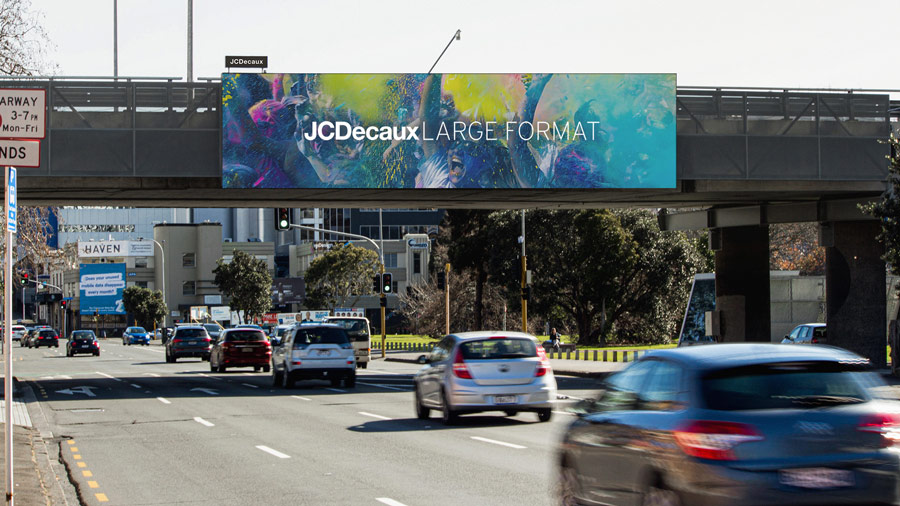AUCKLAND, Today: Leading out-of-home media company JCDecaux NZ has released the results of a world-first study conducted in partnership with global neuro-analytics company, Neuro-Insight.
JCD senior insights & strategy specialist Victoria Parsons said: “Emotional aspects of advertising are known to be more memorable.
“The JCDecaux-commissioned study proved that priming audiences using Large Format makes mobile advertising more memorable and thus more effective in influencing future purchase outcomes.”
“The objectives of the study were to understand how Large Format influences future purchase intent, and how priming people with Large Format impacts their subconscious response to mobile advertising.
“It also looked at mobile advertising priming by out-of-home, which has never been investigated before using neuroscience techniques and looks at how the inclusion of Large Format within the channel mix, improves the effectiveness of mobile advertising.
“The key metric measured was long-term memory encoding [ME], which occurs when the brain encodes information interesting enough to store to the subconscious, meaning it can be recalled in buying situations.
“When ME peaks surpass 0.70, there is an 86% correlation to sales, proven by econometric studies.
When looking at Large Format in isolation, the highest peak ME score for JCDecaux Large Format sites was 1.25 – a very strong neural response. Large Format ME peaks tended to be right brain (global ME) responses, showing emotional intensity and deep connection with the stimulus (creative on Large Format sites).
“Digital sites delivered an 8 per cent higher ME score versus static. Local Neuroscience studies report TV has an average peak ME score of 0.68, while radio’s average peak ME is 0.60. A Large Format average ME of 0.69 shows Large Format delivers neural impact in the same range as a 15-sec tvc.
“Emotional aspects of advertising are known to be more memorable.”
Neuro-Insight MD Brian Hill said: “Brands and advertisers that use Large Format can drive a deeper connection with consumers due to the emotionally intense experience people have with commanding large out of home, indicated by the high ME peaks seen in this study.
“Neuroscience proves a very high correlation with future purchase behaviours when high peaks, such as these are seen. Priming audiences with Large Format advertising increases the effectiveness of mobile creative – particularly in the way it changes the subconscious response to mobile advertising, from a detailed left brain response, to a global right brand response. This was the powerful insight from this study.”
“When looking at how priming by Large Format influenced memory encoding for mobile ads, the findings showed the effectiveness of mobile advertising grew 8 per cent. When unprimed, the subconscious brain response to mobile advertising has a detailed (left brain) bias; when primed by Large Format, this bias becomes global (right brain). That is, the brain, when primed, responds more to the meaning, connotation or feelings conveyed in the mobile ads, rather than the detail, content or price. The brain responds differently to the same piece of creative, with the only difference being one group had been primed by Large Format prior to the mobile experience.
“The ME score of the mobile ads among participants primed by Large Format grew by 8 per cent overall, versus the participants who had not been exposed to Large Format, highlighting that exposure to Large Format makes mobile advertising more engaging. The increase in ME score was even more significant for weak mobile creative, which increased by up to 81 per cent when audiences were primed by Large Format.
“The methodology for this study involved 137 people taking part in a 30-minute virtual car journey, during which they were exposed to 12 JCDecaux static and digital sites displaying three campaigns and nine executions from partner brands – Countdown, Trade Me and Trade Tested. A statistically robust Neuroscience cell is 50 people, so a sample this size gives statistical certainty. To compare a primed and unprimed group, the 137 respondents were split for the second part of the study in which respondents were shown mobile creative from the same brands. One group saw this mobile creative after being ‘primed’ by Large Format the other group saw the mobile creative prior to the virtual car journey. Priming refers to being exposed to Large Format, prior to a mobile execution.
“This is the fourth proprietary study, conducted in partnership with market-leading research agencies, to gain a deeper understanding of how JCDecaux touchpoints connect with audiences, over the last three years. It follows an eye-tracking study in 2019, a brand sentiment study in 2020, and an evolving role of Out-of-Home study in 2021.”
About JCDecaux
JCDecaux has 1 million advertising panels in 80 countries and 13,000 employees. Its Australian and New Zealand businesses includes 40,000 assets spanning airports, rail, transit, static and digital billboards.
Share this Post
The post World-first study proves influence of Large Format appeared first on M+AD!.

More Stories
City Cast, Unprofitable but Expanding, Finds Podcast Traction in a Radio Model
WM New Zealand works with The Goat Farm on rebrand
Scope Media rebrands as Scope Communications